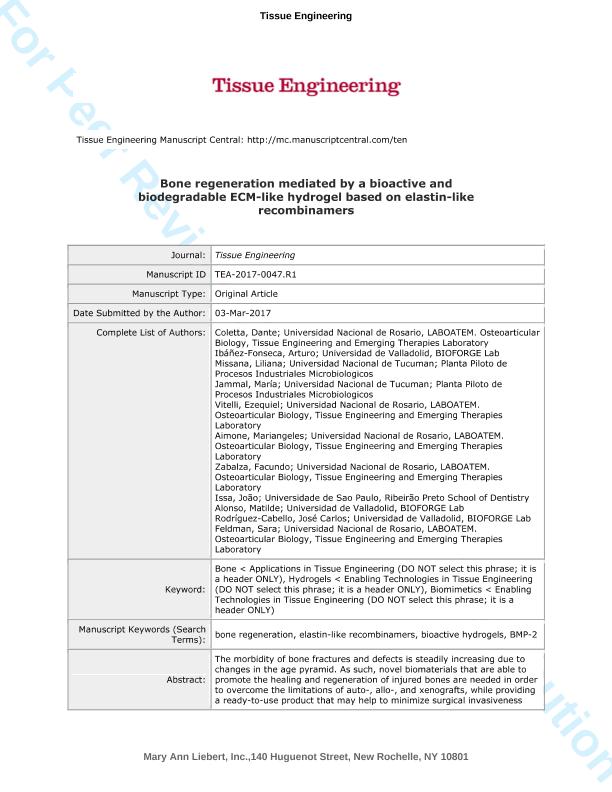Artículo
Bone regeneration mediated by a bioactive and biodegradable extracellular matrix-like hydrogel based on elastin-like recombinamers
Coletta, Dante Jesus ; Ibáñez Fonseca, Arturo; Missana, Liliana Raquel
; Ibáñez Fonseca, Arturo; Missana, Liliana Raquel ; Jammal, María Victoria
; Jammal, María Victoria ; Vitelli, Ezequiel J.; Aimone, Mariangeles; Zabalza, Facundo; Issa, João P. Mardegan; Alonso, Matilde; Rodríguez Cabello, José Carlos; Feldman, Sara
; Vitelli, Ezequiel J.; Aimone, Mariangeles; Zabalza, Facundo; Issa, João P. Mardegan; Alonso, Matilde; Rodríguez Cabello, José Carlos; Feldman, Sara
 ; Ibáñez Fonseca, Arturo; Missana, Liliana Raquel
; Ibáñez Fonseca, Arturo; Missana, Liliana Raquel ; Jammal, María Victoria
; Jammal, María Victoria ; Vitelli, Ezequiel J.; Aimone, Mariangeles; Zabalza, Facundo; Issa, João P. Mardegan; Alonso, Matilde; Rodríguez Cabello, José Carlos; Feldman, Sara
; Vitelli, Ezequiel J.; Aimone, Mariangeles; Zabalza, Facundo; Issa, João P. Mardegan; Alonso, Matilde; Rodríguez Cabello, José Carlos; Feldman, Sara
Fecha de publicación:
12/2017
Editorial:
Mary Ann Liebert
Revista:
Tissue Engineering Part A
ISSN:
1937-3341
Idioma:
Inglés
Tipo de recurso:
Artículo publicado
Clasificación temática:
Resumen
The morbidity of bone fractures and defects is steadily increasing due to changes in the age pyramid. As such, novel biomaterials that are able to promote the healing and regeneration of injured bones are needed to overcome the limitations of auto-, allo-, and xenografts, while providing a ready-To-use product that may help to minimize surgical invasiveness and duration. In this regard, recombinant biomaterials, such as elastin-like recombinamers (ELRs), are very promising as their design can be tailored by genetic engineering, thus allowing scalable production and batch-To-batch consistency, among others. Furthermore, they can self-Assemble into physically crosslinked hydrogels above a certain transition temperature, in this case body temperature, but are injectable below this temperature, thereby markedly reducing surgical invasiveness. In this study, we have developed two bioactive hydrogel-forming ELRs, one including the osteogenic and osteoinductive bone morphogenetic protein-2 (BMP-2) and the other the Arg-Gly-Asp (RGD) cell adhesion motif. The combination of these two novel ELRs results in a BMP-2-loaded extracellular matrix-like hydrogel. Moreover, elastase-sensitive domains were included in both ELR molecules, thereby conferring biodegradation as a result of enzymatic cleavage and avoiding the need for scaffold removal after bone regeneration. Both ELRs and their combination showed excellent cytocompatibility, and the culture of cells on RGD-containing ELRs resulted in optimal cell adhesion. In addition, hydrogels based on a mixture of both ELRs were implanted in a pilot study involving a femoral bone injury model in New Zealand white rabbits, showing complete regeneration in six out of seven cases, with the other showing partial closure of the defect. Moreover, bone neoformation was confirmed using different techniques, such as radiography, computed tomography, and histology. This hydrogel system therefore displays significant potential in the regeneration of bone defects, promoting self-regeneration by the surrounding tissue with no involvement of stem cells or osteogenic factors other than BMP-2, which is released in a controlled manner by elastase-mediated cleavage from the ELR backbone.
Palabras clave:
Bioactive Hydrogels
,
Bmp-2
,
Bone Regeneration
,
Elastin-Like Recombinamers
Archivos asociados
Licencia
Identificadores
Colecciones
Articulos(CCT - ROSARIO)
Articulos de CTRO.CIENTIFICO TECNOL.CONICET - ROSARIO
Articulos de CTRO.CIENTIFICO TECNOL.CONICET - ROSARIO
Articulos(PROIMI)
Articulos de PLANTA PILOTO DE PROC.IND.MICROBIOLOGICOS (I)
Articulos de PLANTA PILOTO DE PROC.IND.MICROBIOLOGICOS (I)
Citación
Coletta, Dante Jesus; Ibáñez Fonseca, Arturo; Missana, Liliana Raquel; Jammal, María Victoria; Vitelli, Ezequiel J.; et al.; Bone regeneration mediated by a bioactive and biodegradable extracellular matrix-like hydrogel based on elastin-like recombinamers; Mary Ann Liebert; Tissue Engineering Part A; 23; 23-24; 12-2017; 1361-1371
Compartir
Altmétricas



